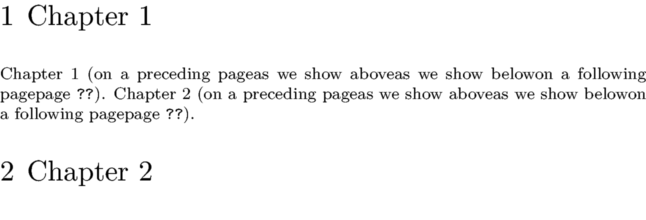Difference between revisions of "Command/atpage"
< Command
Jump to navigation
Jump to search
(Created page with "Documentation for \atpage") |
|||
| Line 16: | Line 16: | ||
The used <code>labeltext</code> entries are <code>hencefore</code> and <code>hereafter</code> for on the same page, or <code>page</code> for a different page.</cd:description> | The used <code>labeltext</code> entries are <code>hencefore</code> and <code>hereafter</code> for on the same page, or <code>page</code> for a different page.</cd:description> | ||
<cd:examples><cd:example title=""><context source="yes"> | <cd:examples><cd:example title=""><context source="yes"> | ||
| − | |||
| − | |||
| − | |||
\chapter[myRef1]{Chapter 1} | \chapter[myRef1]{Chapter 1} | ||
Chapter 1 (\atpage[myRef1]). | Chapter 1 (\atpage[myRef1]). | ||
Chapter 2 (\atpage[myRef2]). | Chapter 2 (\atpage[myRef2]). | ||
| − | |||
| − | |||
\chapter[myRef2]{Chapter 2} | \chapter[myRef2]{Chapter 2} | ||
Revision as of 15:31, 5 September 2020
Contents
\atpage
Summary
The command \atpage is used for labelled page references.
Settings
Description
If the reference resides on the same page the text 'as we show above' or 'as we show below' is typeset in the language which is set by the command \mainlanguage. Otherwise the word 'page' and the page number of the reference is typeset.
The used labeltext entries are hencefore and hereafter for on the same page, or page for a different page.
Examples
Example 1
\chapter[myRef1]{Chapter 1} Chapter 1 (\atpage[myRef1]). Chapter 2 (\atpage[myRef2]). \chapter[myRef2]{Chapter 2}

Example 2
\setuplabeltext[en][hencefore=on this page] \chapter[myRef1]{Chapter 1} Chapter 1 (\atpage[myRef1]).

Notes
See also
- strc-ref.mkvi
- \setuplabeltext for configuring the used label texts
- \at for a reference using only the page number